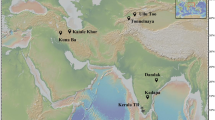Abstract
The longitudinal range-gorge region (LRGR) in Southwestern China, characterized by longitudinal mountain ranges and deep valleys, includes the basins of four major international rivers: the Yuanjiang-Red, Lancang Mekong, Nujiang Salween and Irrawaddy. This region is classified as one of the world’s biodiversity hotspots, and provides an important ecological and economic corridor linking China and Southeast Asian countries. Over the past half century, it has served as a resource base for timber and minerals needed to fuel economic development, which resulted in rapid and drastic changes in ecosystem and species diversity. Proposed and ongoing development programs, such as China’s Great Western Development campaign, Greater Mekong Subregional Economic Cooperation (GMS) and China-ASEAN free trade zone development (“10+1”), threaten to bring unprecedented disturbance to the region’s ecosystems. Present and emerging threats to eco-security have caught tremendous attention worldwide. Therefore, studies on such problems are critical for enhancing ecosystem health and transboundary eco-security.
This paper indicates several multi-disciplinary and cross-sector studies on transboundary resources in this region that will meet three major national needs: 1) identifying core scientific issues of ecological development and infrastructure construction in high plateau and mountainous areas for the Western Development campaign; 2) developing maintenance mechanisms and control methodologies for transboundary eco-security and resource base development; 3) providing scientific grounds for multi-lateral diplomacy, trade and economic cooperation, and conflict resolution as part of China’s opening-up to south Asia. The key subjects to be solved include dynamics and major drive forces of this area, ecological effects caused by major projects construction, and transboundary eco-security and its controlling. The research projects proposed in this article will develop theories on ecosystem change and transboundary eco-security, and provide a scientific basis for national and international development strategies.
Similar content being viewed by others
References
Agee J. K. 1994. Fire and Weather Disturbances in Terrestrial Ecosystems of the Eastern Cascades. Hessburg, P. F. (eds.), Eastside Forest Ecosystem Health Assessment. Vol. III, USDA Forestry Service. Pacific Northwest Research Station PNW 93-0304. USA. Pp. 339–414.
Badenoch N. 2002. Transboundary Environmental Governance: Principles and practice in Mainland Southeast Asia. Washington DC, USA: World Resources Institute.
Baird, A. J. and Wilby R. L. 1999. Eco-hydrology-Plants and Water in Terrestrial and Aquatic Environments. London: Routledge.
CHEN Yiyu. 2003. Global Change and Social Sustainable Development. Advances in Earth Sciences 18(1): 1–3 (In Chinese).
Cunningham W. P., Cunningham M. A. and Saigo B. W. 2003. Environmental Science: a Global Concern (7th ed.). Boston, USA: McGraw-Hill.
De Pietri, D. E. 1992. The Search for Ecological Indicators: Is it Possible to Biomonitor Forest System Degradation Caused by Cattle Ranching Activities in Agrentina? Vegetatio 101: 109–121.
Editors Group of Bio-diversity Research Reports of China. 1998. Report of Bio-diversity of China. Beijing, China: China Environment Science Press. (In Chinese)
FU Chongbin. 1995. Monsoon-driven Ecosystem: Concept and Some Preliminary Evidences. In: Proceedings of the Second International Study Conference on GEWEX in Asia and GAME. Pattaya, Thailand. Pp. 68–70.
Gewin V. 2002. Ecosystem Health: the State of the Planet. Nature 417: 112–113.
Grier C. C. 1975. Wildfire Effects on Nutrient Distribution and Leaching in a Coniferous Ecosystem. Canadian Journal of Forest Research 5: 599–607.
LI Wenhua and WANG Rusong. 2002. Eco-security and Environmental Construction. Beijing, China: Press of Weather. (In Chinese)
LI Wenhua, and ZhOU Xingming. 1998. Ecological Systems and its Optical Utilization Models in Qinghai-Tibet Plateau. Guangzhou: Guangdong People’s Press. (In Chinese)
LIU Yanhua and LI Xiubin. 2001. Frangibility Ecological Environment and Sustainable Development. Beijing, China: Business Affair Press.
Lubchenco J., Olson A. M., Brubaker L. B., et al. 1991. The Sustainable Biosphere Initiative: an Ecological Research Agenda: a Report from the Ecological Society of America. Ecology 72(2): 371–412.
Millennium Ecosystem Assessment(MA). 2003. People and Ecosystems: a Framework for Assessment and Action. Washington. DC, USA: Island Press.
Oliver C. D. and Larson B. C. 1990. Forest and Dynamics. NY, USA: McGraw-Hill.
PAN Yusheng and KONG Xianru. 1998. Evolvement and Dynamics of Geosphere Constructure in Qinghai-Tibet Plateau. Guangzhou: Guangdong People’s Press. (In Chinese)
Perkins J. H. Geopolitics and the Green Revolution. 1997. London: Oxford University Press
QIN Dahe. 2002. General Report of Assessment of Environment Change of West China: Assessment of Environment Change in West China. China Science Press. (In Chinese)
SHI Yafeng, LI Jijun and LI Bingyuan. 1998. Hunching and Environment Change in the Late Cenozoic of Qinghai-Tibet Plateau. Guangzhou: Guangdong People’s Press. (In Chinese)
SUN Honglie and ZHENG Du. 1998. Forming, Evolutiong, and Developing of Qinghai-Tibet Plateau. Guangzhou: Guangdong People’s Press. (In Chinese)
SUN Honglie. 1994. Forming and Evolution of Qinghai-Tibet Platea. Shanghai: Shanghai Science and Technology Press. (In Chinese)
SUN Su. 2002. Earth Sciences: Review and Perspective in the New Century Coming. Jinan: Shandong Educational Press. (In Chinese)
TANG Maocnag, CHENG Gudong and LIN ZhenYao. 1998. Neoteric Climate Change and Its Influence to Environments in Qinghai-Tibet Plateau. Guangzhou: Guangdong People’s Press. (In Chinese)
Vogt K., Patel-Weynand, T., Witten, E., et al. 1997. Ecosystem: Balancing Science with Management. NY, USA: Springer.
Walter H. 1984. Vegetation of the Earth-Ecological System of Geo-biosphere (3rd ed.). New York: Springer-Verlag.
Wolf T. A. and Postel S. L.. 2001. Dehydrating Conflict. Foreign Policy 9: 2–9.
World Resources Institute. 2002. World Resources Report 2000–2001: People and Ecosystems: The Fraying Web of Life. Washongton DC, USA: World Resources Institute.
WU Zhengyi. 1980. Vegetation in China. Beijing, China: China Science Press. (In Chinese)
ZHANG Rongzu, ZHENG Du and YANG Qingye. 1997. Physical Geography of Henduan Mountains. Beijing, China: China Science Press. (In Chinese)
ZHANG Rongzu. 1992. Dry and Hot Valleys of Hengduan Mountains. Beijing, China: China Science Press. (In Chinese)
Author information
Authors and Affiliations
Corresponding author
Rights and permissions
About this article
Cite this article
Liu, J., He, D. Research agenda for understanding transboundary ecosystem changes and eco-security in Southwestern China. J. Mt. Sci. 3, 81–90 (2006). https://doi.org/10.1007/s11629-006-0081-1
Received:
Accepted:
Issue Date:
DOI: https://doi.org/10.1007/s11629-006-0081-1




